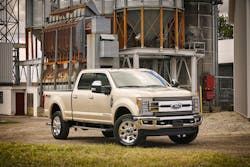A mix of military-grade aluminum and steel will shave 350 lbs. off all the new 2017 Super Duty models being introduced by Ford Motor Co. – a pickup line to be built at the OEM’s Kentucky Truck Plant in Louisville, KY, that will go on sale late next year.
Ford said the “backbone” of the 2017 model Super Duty - which includes the F-250, F-350, F-450, and F-550 designations - is a completely new fully-boxed frame comprised of over 95% high-strength steel that offers up to 24 times stiffer than the previous Super Duty frame.
The truck will also feature the same military-grade aluminum alloy used to construct the OEM’s new F-150 pickup, making the 2017 model Super Duty more dent- and ding-resistant while helping eliminate “red rust” corrosion – all while reducing the weight of the vehicle, noted Craig Schmatz, Ford’s chief engineer for the Super Duty.
“As we remove weight, we’re making Super Duty more productive by giving our customers better towing and payload capability,” he said. “We’re also backing up improved capability with a stronger gasoline and diesel engine lineup.”
The second-generation of Ford’s 6.7-liter Power Stroke V8 diesel engine will be available for the 2017 model Super Duty lineup, along with a 6.2-liter V8 gasoline engine mated to a new six-speed TorqShift-G automatic transmission for the F-250 variant. A 6.8-liter V10 gasoline engine is also an option, Schmatz pointed out, mated to a standard six-speed TorqShift automatic for the bigger F-350, F-450 and F-550 models.
“The bottom line is Super Duty customers will be able to tow and haul more than ever before,” he stressed.
Brian Rathsburg, Ford's marketing manager for the Super Duty, told Fleet Owner that the 2017 model's frame is fully boxed in its pickup truck configuration, with the frame fully boxed under the cab but left in an open C-channel set up after the cab in Chassis Cab mode.
"It's also important to note that the 350 lbs. we saved is actually a net savings; we actually re-invested a portion of the weight we saved from using aluminum alloys back into the truck in the form of bigger axles plus stronger suspension and springs," he pointed out. "It's all about delivering more capability and productivity to both retail and commercial customers."
Ford noted that all three cab options for the 2017 model Super Duty – Regular Cab, SuperCab and Crew Cab – are longer, between 3 and 6 inches longer, according to Rathsburg, and feature a new interior design, including dual compartment glove box, overhead console-mounted auxiliary switches to operate aftermarket equipment, and completely flat SuperCab and Crew Cab second-row floors to make loading large items in the cab easier.
The four fuel tank options for the Super Duty are also going to be larger, Rathsburg noted, meaning that - combined with expected fuel economy improvements - customers should achieve more range per fill up.
There will also be five trim levels available for the 2017 model Super Duty as well, Ford noted – XL, XLT, Lariat, King Ranch and Platinum.
The OEM added that the 2017 model Super Duty also offers 16 new features – from light emitting diode (LED) lighting to adaptive cruise control – with up to seven cameras available to help customers see more angles and monitor conditions surrounding the truck. Those camera options include:
- A center high-mounted stop lamp camera provides visibility into the cargo box, especially for easier hook-up of gooseneck/fifth-wheel trailers;
- A 360-degree camera system that uses four digital, high-definition cameras to give the driver a “bird’s-eye view” of the area surrounding the truck;
- A factory-available trailer camera can be attached to provide visual cues and tips to make backing up trailers easier and safer.
Other new features offer a wide gamut of driver comfort and vehicle safety improvements, including:
- An in-cab trailer tire pressure monitoring system;
- Adaptive steering, which reduces the amount of steering input needed to change direction at low speed, while reducing sensitivity to steering input at higher speeds;
- SYNC 3, Ford’s all-new communications and entertainment system, which offers conversational voice recognition, an easier-to-understand graphical interface, and intuitive smartphone-like 8-inch touch screen;
- A Blind Spot Information System (BLIS) with trailer tow that uses radar sensors in the tail lamps to monitor areas that may not be visible to the driver;
- Lane departure warning that alerts drivers through a series of steering wheel vibrations that mimic rumble strips;
- Adaptive cruise control plus collision warning with brake support, which “pre-charges” the brake system to stop the vehicle faster.
Rathsburg noted that many of those systems are options all the way down through the Super Duty's XL trim level; what's considered the "basic" work truck spec for many commercial customers. "We've also made a lot of smaller changes to boost capability as well, such as moving from 4 to 6 upfitter switches offering increased amperage," he said. "We've got more storage built into the new Super Duty's cab because we know these trucks are 'offices on wheels' for most commercial customers. We're trying to make the Super Duty a more efficient, safer and productive work tool all the way around."
About the Author
Sean Kilcarr
Editor in Chief
Sean Kilcarr is a former longtime FleetOwner senior editor who wrote for the publication from 2000 to 2018. He served as editor-in-chief from 2017 to 2018.
